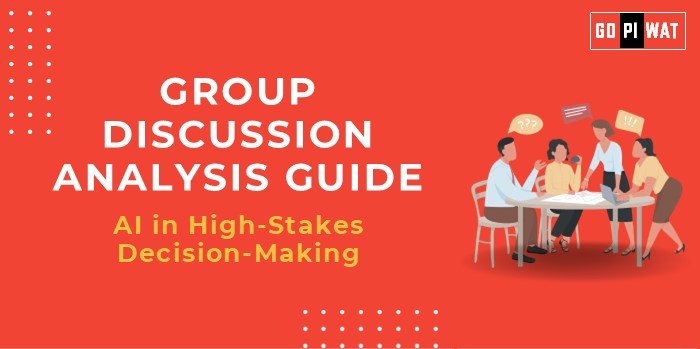📋 GD Analysis Guide: AI in High-Stakes Decision-Making
🌐 Introduction to the Topic
Opening Context: Artificial intelligence (AI) is increasingly integrated into high-stakes decision-making processes, from healthcare diagnoses to autonomous vehicle navigation and financial trading. While AI promises accuracy, efficiency, and scalability, the trust factor in critical scenarios remains a heated debate.
Topic Background: AI’s ability to process vast amounts of data and provide predictive insights has transformed industries. However, instances like biased algorithms in hiring or flawed predictions in medical treatment highlight challenges in its application. With regulators worldwide, such as the EU’s AI Act, scrutinizing AI usage, the question of trustworthiness in high-stakes contexts gains urgency.
📊 Quick Facts and Key Statistics
- AI Market Size: The global AI market is projected to reach $184 billion in 2024, with an expected annual growth rate of 28.46%, resulting in a market volume of $826.70 billion by 2030 (Statista).
- Bias Incidents: Studies have shown that AI systems can exhibit biases, particularly in image generation, where models often produce racially and gender-biased results (Nature).
- Healthcare AI: AI applications in healthcare have demonstrated the potential to reduce diagnostic errors, with some studies indicating significant improvements in accuracy.
- Autonomous Vehicle Failures: AI misjudgments have been implicated in a notable percentage of autonomous vehicle accidents, raising concerns about reliability in critical situations.
- Regulations: Over 33 countries have passed at least one law related to AI between 2016 and 2023, reflecting a global effort to regulate AI applications (IEEE Spectrum).
🤝 Stakeholders and Their Roles
- Governments: Regulate ethical AI use through policies and standards.
- Corporations: Develop and deploy AI for decision-making with transparency.
- Academia: Conduct research on AI ethics, fairness, and explainability.
- End-users (citizens): Demand accountability and protection from AI misuse.
- Global Organizations: Promote international AI governance (e.g., UNESCO).
🏆 Achievements and Challenges
Achievements
- Healthcare: AI-assisted surgeries have been associated with reduced recovery times and improved patient outcomes.
- Finance: AI systems have enhanced fraud detection rates, contributing to more secure financial transactions.
- Environmental Monitoring: Predictive AI models have been utilized to mitigate disaster risks, aiding in proactive measures.
Challenges
- Bias: Algorithmic discrimination remains a critical flaw, as evidenced by AI image generators producing biased results (Nature).
- Transparency: Black-box models hinder trust in life-impacting decisions due to their lack of interpretability.
- Accountability: Assigning responsibility in AI failures remains unclear, complicating legal and ethical considerations.
🌍 Global Comparisons
- Success: Finland’s AI-driven education system fosters inclusion, serving as a model for integrating AI ethically.
- Challenges: U.S. court rulings have highlighted biases in AI-assisted sentencing, underscoring the need for careful oversight.
📖 Case Studies
- Healthcare: IBM Watson’s challenges in clinical trials due to data misinterpretation illustrate the complexities of AI in medicine.
- Autonomous Vehicles: Incidents involving Tesla’s AI misreading road conditions have raised concerns about the reliability of autonomous driving systems.
🛠️ Structured Arguments for Discussion
- Supporting Stance: “AI can improve precision and reduce human error in high-stakes domains like surgery or finance.”
- Opposing Stance: “AI’s inherent biases and lack of accountability make it unreliable in critical decisions.”
- Balanced Perspective: “AI’s benefits are undeniable, but its trustworthiness requires rigorous regulation and transparency.”
🚀 Effective Discussion Approaches
- Opening Approaches:
- “Recent AI failures in autonomous vehicles spark questions about its readiness for high-stakes roles.”
- “With over 33 countries enacting AI-related laws, is trust in AI truly global?”
- Counter-Argument Handling:
- Rebut biases by suggesting AI explainability mechanisms.
- Argue for hybrid models combining AI with human oversight.
📈 Strategic Analysis of Strengths and Weaknesses
- Strengths: Efficiency, scalability, predictive accuracy.
- Weaknesses: Bias, lack of interpretability, data dependency.
- Opportunities: AI governance, ethical AI advancements.
- Threats: Public mistrust, regulatory backlash, misuse risks.
🎓 Connecting with B-School Applications
- Real-World Applications: AI-driven analytics in operations, marketing, and strategy.
- Sample Interview Questions:
- “How can organizations address AI biases effectively?”
- “What role does AI play in decision-making for businesses?”
- Insights for B-School Students:
- Explore AI ethics for internships.
- Engage in AI-human collaborative project themes.


